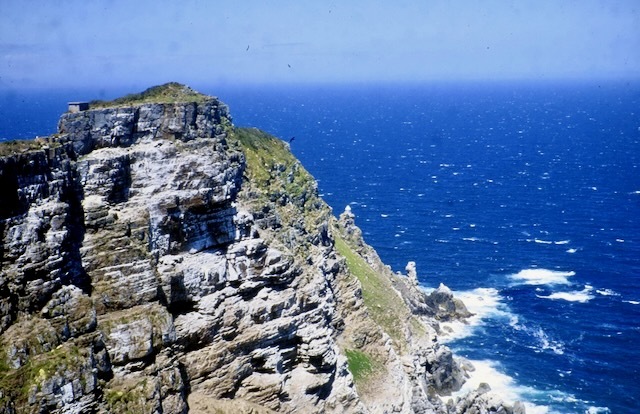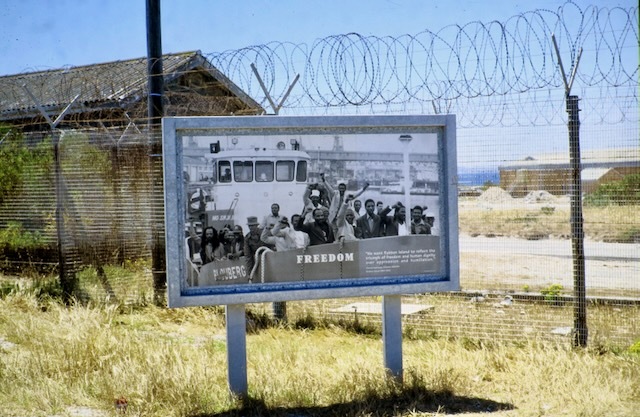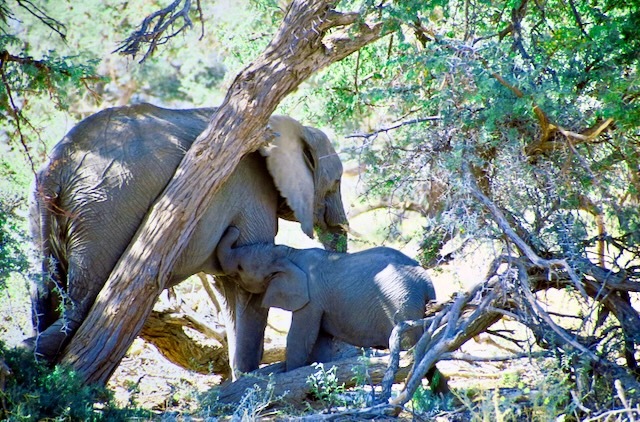November 12, 2000 to November 30, 2000
Into Africa - 2000
My first trip to Africa was 25 years ago, a journey that had a profound and lasting impact in shaping my views of travel. I recently discovered the handwritten journal I kept during the trip, something I had considered lost or misplaced over the years. Re-reading the journal prompted me to go through scores of photos from the trip – some taken by me on an old Nikon FE2; others taken by my traveling companion Sean on his new digital camera, somewhat of a novelty at the time. As I prepared for my return to Africa, it seemed a good time to revisit some of the thoughts and images that still resonate in my memory.
I went to South Africa at the invitation of Sean, a former student who had spent three years working in my lab during his undergraduate studies at Iowa State. He was bound for medical school but before embarking on his MD/PhD program he spent a year in Cape Town on a Rotary Fellowship. Toward the end of his year, he asked if I was interested in joining him on a trip to Namibia, a place he was keen to visit before returning to the US. I jumped at the chance and left all the planning to Sean. It was something at which he excelled.
I departed the US a few days after the 2000 Bush-Gore election, when the US was focused on Florida, butterfly ballots and hanging chads. When I arrived in Cape Town, everyone was a-abuzz about the US elections, plying me for information and perspective and offering their help in any election monitoring we might need. When asked if I was worried about a constitutional crisis, I shook my head and assured them that the US constitution was strong, confident that once the election results were finalized, everyone would accept them and move forward, as we did. It was unfathomable that things would so radically change in just two decades.
Sean had planned a wonderful itinerary. Our first week was spent in and around Cape Town, staying with a Rotary family and enjoying some of the best of what Cape Town had to offer; a cable car to the top of Table Mountain; high tea at the Mount Nelson Hotel; and a ten-course fish braii at a beachside restaurant in Langebaan where diners took short dips in the Atlantic between courses. Most memorable though were the outings to the Cape of Good Hope and a visit to Robben Island Museum.
Sean, myself and two undergrad Rotary scholars from Australia took a day trip to the Cape of Good Hope – located close to the tip of the African continent where the waters of the Atlantic and Indian Ocean converge. We frolicked on Diaz beach and found a nice rock for our picnic lunch before climbing up and along the ridge of the cape. As I stood looking down and out over the water, the point of the cape visible below me, I had the extraordinary sensation of my precise location on earth – I imagined myself the masthead figure on the steamship Africa, making her way across the seas to Antartica. It was an extraordinary moment that continues to evoke wonder.

| Heart | 4 | Comment | 0 | Link |

| Heart | 3 | Comment | 0 | Link |
Robben Island is located a little more than four miles from Cape Town in Table Bay. Once used as a leper colony, it gained notoriety as a prison for political activists opposed to South Africa’s apartheid government. Nelson Mandela was imprisoned at Robben Island for 18 years as were Kgalema Motlanthe and Jacob Zuma, both anti-apartheid activists who, like Mandela, were later elected president of South Africa. Political prisoners were released from Robben Island in May, 1991 and the prison was closed in 1996. Today the island operates as a living museum with former guards and prisoners serving as guides. In 1999, Robben Island was declared a World Heritage Site for its importance to South Africa's political history and development of a democratic society.
Sean and I visited Robben Island Museum on a bright sunny spring day, accompanied by scores of smiling schoolchildren on a class field trip. Our guide was Sindile Mngqibisa, a former prisoner who told us the history of the island and shared his experiences as a prisoner. He emphasized the importance of the Truth and Reconciliation project which was a commission initiated by Mandela after he was elected President. The goal was to bring about reconciliation by uncovering the truth about apartheid. Evidence was provided by both victims and perpetrators with the goal of reconciliation, not prosecution. Seeing former prisoners and guards working together at the Robben Island Museum was a clear demonstration of how such a project could succeed. Together with the smiling faces and evident joy of the young school children, the. Day’s experience left me hopeful for the future of South African.

| Heart | 3 | Comment | 0 | Link |

| Heart | 2 | Comment | 0 | Link |

| Heart | 2 | Comment | 0 | Link |

| Heart | 2 | Comment | 0 | Link |

| Heart | 1 | Comment | 0 | Link |

| Heart | 3 | Comment | 0 | Link |
Namibia
After a five days in Cape Town, Sean and I flew to Windhoek, Namibia where we rented a small sedan, stocked up on water and provisions and headed off on to see some sand dunes and wildlife. Our first stop was the Daan Viljoen Game Reserve, located just outside Windhoek. We spent the afternoon exploring the reserve on foot – something I found it both thrilling and a bit nerve wracking. However Sean assured me that the various wildebeests, antelope, zebras and baboons would pay us no mind. We overnighted in a small cabin on the preserve and left the next morning for Sesriem, located near Sossusvlei and the Namib Desert.
Sossusvlei is an expanse of dried salt and clay pans surrounded by towering red sand dunes located in the southern part of the Namib Desert. The name derives from the Afrikaans word for marsh (vlei), and the Nama word for no return (sossus). The name technically refers to a single vlei in the park, but is generally used to refer to other vleis and dunes within the area. The two days spent exploring this unique and breathtaking region were the most remarkable of my nearly three weeks in southern Africa.
Our first day was guide free – we arrived at the entrance to the Namib-Naukluft National Park just before sunrise, the second car in line waiting for the park to open. At that early hour, the marked contrast between the light and shaded sides of the dunes highlight the shapes and contours of sand. Later, as the sun rises, the contrast is flattened in a way that leaves the landscape looking something like an impressionist painting. We drove 60 km through the park to the 2X4 parking lot, a drive filled with countless stops and gasps of wonder as dunes towered above and emus and oryx scooted about in the early dawn. Once at the parking lot, we headed off on foot through the desert to Hidden Vlei where we took a stab at climbing the dunes. Or should I say that I took a stab while Sean made it all the way to the top of Crazy Dune.
That night we stayed in the first of three upscale safari camps we had booked. The next day our guide Isaac took us farther into the park to Dead Vlei, a dystopian landscaped of dunes, salt pan, and seemingly dead trees. Isaac taught us about life can survive in such a harsh environment and shares how he gave up his life as a company manager in order to help others discover the wonders of his homeland.

| Heart | 9 | Comment | 2 | Link |
2 months ago

| Heart | 5 | Comment | 2 | Link |

| Heart | 3 | Comment | 0 | Link |

| Heart | 4 | Comment | 0 | Link |

| Heart | 3 | Comment | 0 | Link |
From Sossusvlei, we drove north through the sand to Swakopmund, a city that still carries the German influence forged during colonial times. Though celebrated as a happening seaside town with lots of attractions, both Sean and I felt a bit oppressed, probably due the venomous racism spewed forth by our host family. On the positive side, I got the sand removed from my camera lens at a fine German camera shop, and Sean and I were mistaken for safari guides.
Our next stop was the Damaraland Wilderness Camp, another posh safari camp where we were hoping to see desert elephants. We spent two nights in Damaraland, enjoying a late afternoon drive on the lookout for meercats and a hugely successful day among a small herd of desert elephants. Sean also convinced the managing staff to let us go out alone on an impromptu exploration of a cliffside cave where Sean was on the lookout for evidence of human toolmaking.

| Heart | 4 | Comment | 0 | Link |

| Heart | 1 | Comment | 0 | Link |

| Heart | 5 | Comment | 2 | Link |
Our final destination in Namibia was the Etosha National Park, near the northern border of Namibia. The main feature of the park is a large salt pan so vast that it can be seen from outer space. There are abundant wildlife in the park, including black and white rhinos, lions and the famed White Ghost Elephants of Etosha. Our time here felt more like a classic safari, with day and night game drives where we saw most of the animal species that inhabit the park. My favorite times were spent watching the animals at the watering hole: the evident joy of elephants squirting themselves and their friends; the pecking order of the various species wherein the springboks always give way to oryx and kudu.

| Heart | 5 | Comment | 0 | Link |

| Heart | 3 | Comment | 0 | Link |

| Heart | 4 | Comment | 0 | Link |
After returning to Cape Town we rented a car and drove east to Indian Ocean and visited with Sean’s Rotary friends who lived in Mossel Bay. I was again struck by their continuous attention and concern regarding the outcome of the US election, which remained undecided at that point. There were serious discussions long into the night on the US model of democracy and the challenges for post-apartheid full democracy in South Africa.
Throughout our travels we had taken every opportunity to chat up the locals and get their perspectives on life. Most were optimistic, regardless of race or nationality but we also witnessed lingering racism and growing disillusionment voiced by some in Namibia. It was clear that these were countries still shedding the vestiges of colonialism and eager to move forward into the 21st century. I was extremely fortunate to have to have traveled with Sean, whose youth, knowledge and sense of adventure opened doors and allowed me to glimpse the complexities and wonders of these two countries. It was a seminal experience that revealed the importance of interpersonal interactions and laid a foundation for my subsequent international travel experiences.
| Rate this entry's writing | Heart | 12 |
| Comment on this entry | Comment | 8 |
2 months ago
Times do change, and I have been dismayed to see South African support for Russian dictatorship and aggression. And oh, they exported Elon Musk, hummphh.
2 months ago
Looking forward to seeing the rest of your current trip through 25 year older lenses!
2 months ago
2 months ago
2 months ago
2 months ago














